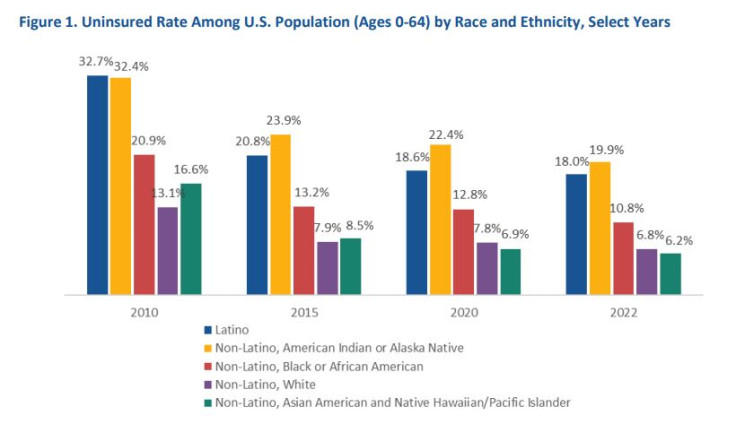
The uninsured rate for nonelderly Latinos dropped from 32.7 percent to 18 percent from 2010 to 2022, but Latinos are more than twice as likely to be uninsured as non-Hispanic Whites, according to a report from the U.S. Department of Health and Human Services (HHS).
The study, titled "Health Insurance Coverage and Access to Care Among Latino Americans: Recent Trends and Key Challenges," outlines that "by introducing new affordable coverage options, the ACA (as the Affordable Care Act is known) has significantly reduced the number of uninsured Americans," including Latinos.
Between 2010 and 2022, the number of Latinos with health insurance increased by 15.6 million, thanks to these types of policies that continue today, the document says based on estimates of insurance coverage from the American Community Survey (ACS) conducted by the Census Bureau.
Latinos, who were the most likely to be uninsured when the ACA was enacted, experienced the largest percentage point decline in their uninsured rate in the early years after the law's coverage expansions took effect.
While the uninsured rate for adults fell 7 percentage points between 2010 and 2015, from 18 percent to 11 percent, the uninsured rate for Latinos fell 11.9 percentage points, from 32.7 percent in 2010 to 20.8 percent in 2015.
By 2020, the uninsured rate among nonelderly Latinos was 18.6 percent and continued to decline to 18 percent by 2022.
However, the gap with the non-Hispanic white population has widened slightly over the years.

In 2010, the uninsured rate among nonelderly Latinos was 2.3 times that of non-Hispanic whites. In 2022, the uninsured rate among nonelderly Latinos was 2.6 times that of the non-Hispanic white population.
"The Biden Administration has built on the ACA to further expand health insurance coverage," the study outlines, referring to policies such as the American Rescue Plan (ARP) and the Inflation Reduction Act (IRA) that "significantly expanded and enhanced" tax credits for purchasing health insurance through the ACA Marketplaces.
"This plus a major investment in Navigator funding, outreach and education led to an over 100 percent increase in Marketplace enrollment among Latinos from 2020 to 2023, with 3.4 million Latinos enrolled in Marketplace coverage 2023," the study says.
"The gain in coverage led to improved access to care and affordability. Still, the uninsured rate for Latinos remains higher than the rate for non-Latino Whites, and Latinos continue to worry about paying their medical bills at rates higher than the rate for non-Latino Whites," the document says among its conclusions.
"Because Latinos disproportionately live in states that have not yet implemented the ACA Medicaid expansion, full expansion is critical and has the potential to further reduce the Latino uninsured rate by 16 percent," the study stresses.
© 2025 Latin Times. All rights reserved. Do not reproduce without permission.





